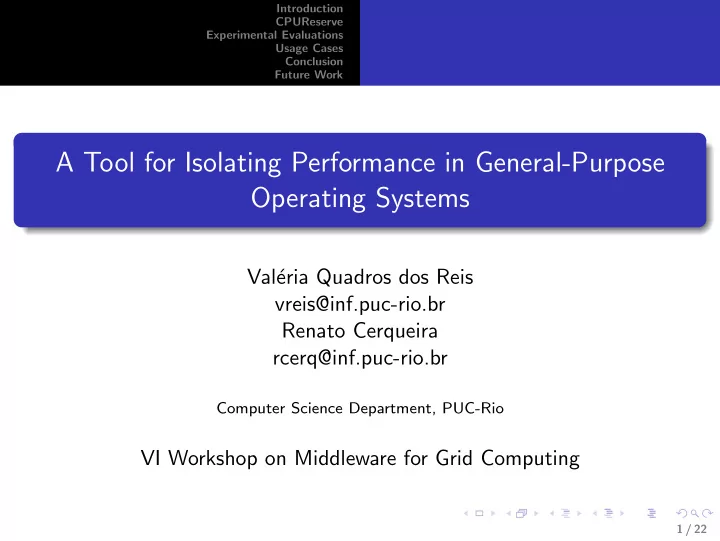

Introduction CPUReserve Experimental Evaluations Usage Cases Conclusion Future Work A Tool for Isolating Performance in General-Purpose Operating Systems Val´ eria Quadros dos Reis vreis@inf.puc-rio.br Renato Cerqueira rcerq@inf.puc-rio.br Computer Science Department, PUC-Rio VI Workshop on Middleware for Grid Computing logo 1 / 22
Introduction CPUReserve Experimental Evaluations Usage Cases Conclusion Future Work Contents 1 Introduction 2 CPUReserve 3 Experimental Evaluations 4 Usage Cases 5 Conclusion 6 Future Work logo 2 / 22
Introduction CPUReserve Experimental Evaluations Usage Cases Conclusion Future Work Motivation Processing Reservation is an issue desired in many scenarios: Grid Computing On-demand Computing Multimedia Applications logo 3 / 22
Introduction CPUReserve Experimental Evaluations Usage Cases Conclusion Future Work Motivation General-Purpose Operating Systems do not provide efficient mechanisms for processing reservation. Alternatives: Kernel Modification Need for recompiling Virtualization Overhead for instanciating and managing the VMs User-level reservation managers Guarantees performance isolation for soft real-time applications The best approach for our needs logo 4 / 22
Introduction CPUReserve Experimental Evaluations Usage Cases Conclusion Future Work DSRT (Dynamic Soft Real Time Scheduler) Project was discontinued; Communication done by shared memory; Manages processing, but not processors; Does not treat idle processing; No separation between the reservation mechanism and the reservation policies; Highly complex code. logo 5 / 22
Introduction CPUReserve Experimental Evaluations Usage Cases Conclusion Future Work CPUReserve A new tool for processing reservation at user-level. CPUReserve can be used in scenarios of: Distributed Computing; Grid and On-demand Computing; Flexible resource usage; Opportunistic Computing; Multi-processed architectures. logo 6 / 22
Introduction CPUReserve Experimental Evaluations Usage Cases Conclusion Future Work Execution Server ./server <port> <procs_bit_mask> <system_limit> Client ./client <mac:port><period><slice><cons><exec><params...> ./adapt <mac:port><period><slice><cons><pid> logo 7 / 22
Introduction CPUReserve Experimental Evaluations Usage Cases Conclusion Future Work Architecture Server IO Monitor Client Handler Alarm Handler Alarms Msg Handler Monitor Reserve Adapt Process Tree logo 8 / 22
Introduction CPUReserve Experimental Evaluations Usage Cases Conclusion Future Work Implementation Details Use of system calls in order to enforce new scheduling rules; Scheduling policies used: SCHED RT to enforce execution SCHED OTHER to explore idle processing The server process is executed with the highest priority to real-time processes; Client processes are executed with the second highest priority to real-time processes; Example: An application should be executed with 500 ms out of every 1000 ms. logo 9 / 22
Introduction CPUReserve Experimental Evaluations Usage Cases Conclusion Future Work CPUReserve’s Effectiveness How do applications with and without reservation behave when they are executed concurrently? Two busy-waiting applications: App1 being serviced without reservation, that is, in a best-effort way; App2 being initially serviced with 20% reservation in the non-working-conserving mode. logo 10 / 22
Introduction CPUReserve Experimental Evaluations Usage Cases Conclusion Future Work CPUReserve’s Effectiveness logo 11 / 22
Introduction CPUReserve Experimental Evaluations Usage Cases Conclusion Future Work CPUReserve’s Scalability Estimate the amount of resources the CPUReserve server consumes to support an increasing number of client processes. Testbed Intel Centrino Duo 1,66 GHz, 1 G memory and running kernel 2.6.24 Parametrization Server initialised with 2 processors; Clients request reservations of 10 ms out of every 1000 ms. logo 12 / 22
Introduction CPUReserve Experimental Evaluations Usage Cases Conclusion Future Work Experimental Evaluations Scalability Results: Server consumes less than 1% of CPU, 18 MB of virtual memory, and 732 KB of resident memory; As the number of clients increases: CPU and memory consumption increases linearly; It was not possible to make experiments with over 50 clients. logo 13 / 22
Introduction CPUReserve Experimental Evaluations Usage Cases Conclusion Future Work Limitations Limited by the Operating System; Can interfere on or be interfered by other processes running out of CPUReserve; Cannot reserve all the machine’s processing capacity. logo 14 / 22
Introduction CPUReserve Experimental Evaluations Usage Cases Conclusion Future Work Usage Cases To reserve processing in the execution nodes of CSBase; To measure the accuracy of some benchmarks used in CSBase. Is the benchmark result consistent when the workload of the machine being measured varies? Experiments: execution of the benchmark with reservation varying from 10 to 100% of a machine’s processing capacity. logo 15 / 22
Introduction CPUReserve Experimental Evaluations Usage Cases Conclusion Future Work CPUReserve and Virtualization CPUReserve can be used with different virtualization techniques in order to constrain: The processing of new virtual machines; CPUReserve server triggers a new instance of KVM; The processing of running processes inside a VM. Xen 3.2 initialised with SEDF scheduler; CPUReserve running inside a Xen domain. logo 16 / 22
Introduction CPUReserve Experimental Evaluations Usage Cases Conclusion Future Work Conclusion CPUReserve is a light and easy-to-use tool which provides application performance isolation without the need for kernel recompiling or for virtualization overload; Tests have shown that the CPUReserve server consumes few resources; consequently, it can support a great number of clients simultaneously; CPUReserve can be used in modern computational environments such as multi-institutional opportunistic grids with multi-processed architecture machines. logo 17 / 22
Introduction CPUReserve Experimental Evaluations Usage Cases Conclusion Future Work Future Work The study of machine learning techniques to parametrize reservations; The insertion of new kinds of resource reservation – disk, memory, and network; The development of new policies for resource sharing. logo 18 / 22
Introduction CPUReserve Experimental Evaluations Usage Cases Conclusion Future Work Contacts Val´ eria Quadros dos Reis vreis@inf.puc-rio.br Renato Cerqueira rcerq@inf.puc-rio.br logo 19 / 22
Introduction CPUReserve Experimental Evaluations Usage Cases Conclusion Future Work Decision Tree Alarm Terminated Stopped Running exec(slice) RT OTHER makeRT execSlice !execSlice exec(slice) !passedPer passedPer !passedPer passedPer conserv !conserv enough !enough exec(slice) exec(slice)* time time makeOTHER stop until exec(remaining_slice) exec(next_per)* logo next_per exec(next_per) 20 / 22
Introduction CPUReserve Experimental Evaluations Usage Cases Conclusion Future Work Experimental Evaluations logo 21 / 22
Introduction CPUReserve Experimental Evaluations Usage Cases Conclusion Future Work CPUReserve and Xen logo 22 / 22
Recommend
More recommend